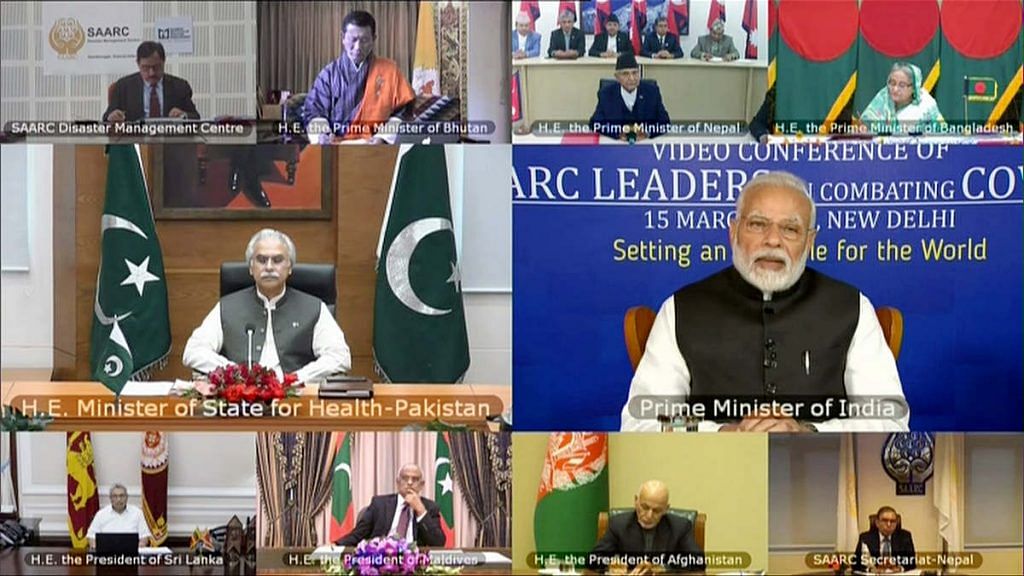As India battles the deadly coronavirus inside, and positive cases exceed 20 lakh, another enemy has shown up at the borders – new maps.
While map propaganda or cartographic wars are not unknown to the world, it is nonetheless unprecedented in this particular part of the globe.
Today, not only have the countries in our immediate neighbourhood made it clear that they no longer care about India’s watchful eye, countries such as Pakistan and Nepal are even changing their political maps as they deem fit as New Delhi watches haplessly. The answer now lies in India reinvesting its energies in regional blocs.
This is even more critical as India gears up to become one of the non-permanent members of the UN Security Council for the eighth time from January 2021, for a period of two years.
Also read: Pakistan’s new map an opportunity for India. Now, Delhi just needs to play its cards right
Volatile borders
Just as borders were a sensitive political issue in 1947 when India achieved Independence from over 200-years of British rule, they remain so even now. Successive governments have avoided addressing the wounds inflicted upon this region by imprudent British map-making.
Nevertheless, despite challenges, India had ably played the role of a regional ‘Big Brother’ and embraced all its ‘younger brothers’ quite efficiently with its democratic and secular values, guided by a stable Constitution, at a time when almost all of them were facing inherent governance challenges.
That image of India has begun to erode today.
First Nepal, now Pakistan has unilaterally changed their political maps showing disputed regions with India as part of their own countries.
In May, Nepal claimed about 335 sq. km of the entire Kalapani region as its own — an area that has been recognised as a disputed by both Kathmandu as well as New Delhi.
Earlier this week, Pakistan went a step further and claimed not just the areas that are disputed with India as their own, they also pencilled in a certain portion of Junagadh in Gujarat in its new map.
Also read: Who needs a Google Map? Naya Pakistan is Naya Mapistan
Mapping out politics
Some may shrug off the map-making as some kind of ‘Chinese play’ in the neighbourhood or some churlish steps to poke India, but the question is who triggered this cartographic war in South Asia?
Following the scrapping of Article 370 and 35A on 5 August last year, India released a new political map on 2 November showing Jammu and Kashmir as two union territories — J&K and Ladakh.
This was seen as a unilateral act by our neighbours, especially Nepal, which protested the move and urged for a resolution on the Kalapani border issue.
This is nothing new in a world shaped by geopolitics. The cartographic battle or map propaganda climaxed during World War I that helped shaped the theatres of war.
In The Revenge of Geography: What the Map Tells Us About Coming Conflicts, author Robert Kaplan describes how India needs to be careful in its strategic decisions because it is surrounded by hard geography that threatens to “implode, explode or maintain a fragile equilibrium”. This region was mostly saved from map adventures. But not anymore.
Also read: Nepal to send its controversial new map to UN, Google this month
Go local, in strategy too
The Modi government now needs to get its act together and promote some of the regional setups that would bind these countries together – such as the South Asian Association for Regional Cooperation (SAARC) and Bay of Bengal Initiative for Multi-Sectoral Technical and Economic Cooperation (BIMSTEC). India cannot cede ground to Beijing by neglecting regional blocs.
The diffidence of the Modi government to inject new life in SAARC due to a belligerent Pakistan has made India look weak and unwilling to cooperate in poverty alleviation that continues to pose the single biggest challenge in the sub-region.
SAARC and BIMSTEC can act as major binding factors but instead, the Modi government chose to prioritise strategic groupings such as Indo-Pacific and Quadrilateral security dialogue much more than the regional frameworks.
Pakistan is not a member of BIMSTEC, but even then this sub-regional organisation has tremendous potential.
In reality, changing political maps may have little or no relevance unless it is recognised by the United Nations. But it does have an impact when Google Maps has come to play a key role in defining borders that billions of users follow. Nepal recently stated that it will send its new political map to Google too.
India cannot afford to lose a second more and establish a sustained dialogue with its neighbours. It should immediately see that the next SAARC Summit is held on an urgent basis. Stalling it will serve no purpose. While some may point out that SAARC was too weak to fulfil its promise, it is still in New Delhi’s interest to embolden that platform, especially because Pakistan is its next chair.
This will not only thaw the ice that is mounting between neighbours, but will also help New Delhi take that strategic quantum leap.
Views are personal.
